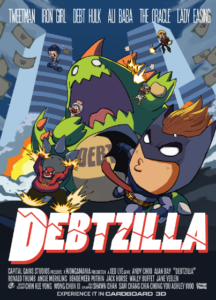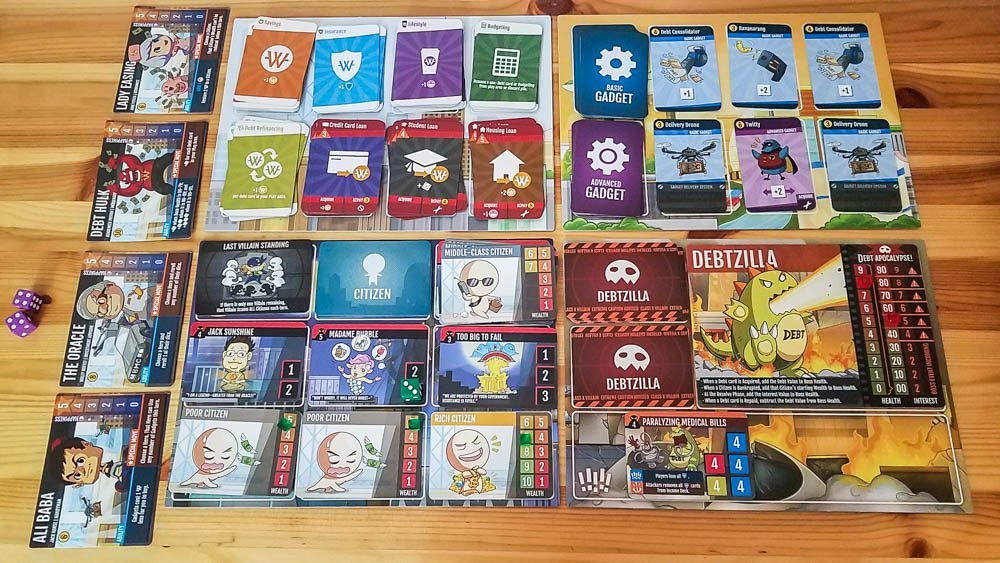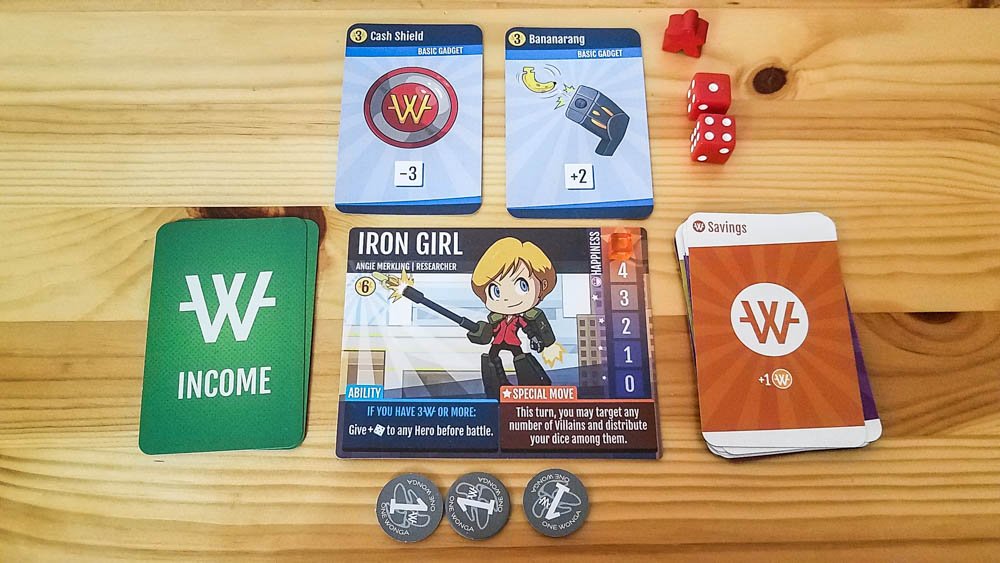Debtzilla Review
Year: 2018 | Players: 2-4 | Minutes: 60+ | Ages: 14+
This Debtzilla review was made after playing the game five times. We were sent a copy of this game by the publisher in exchange for an honest review.
What is Debtzilla?
Debtzilla is a cooperative dice rolling and deck building game in which you play as heroes who are attempting to prevent villains from scamming the citizens in your city. The game was designed by Xeo Lye and is published by Capital Gains Studio.
Debtzilla Gameplay
In Debtzilla, you get to play as heroes who are attempting to keep villains from bankrupting the city’s citizens. Each hero uses gadgets and their unique special abilities to defeat the villains and, hopefully, take down the boss.
Until you make it to the final boss, there are four phases in each round:
- Working Phase – During this phase you’re just ordinary citizens going about your lives, making money and possibly picking up some debt. You’ll draw five Income cards from your deck and will play those cards to gain resources (money, happiness, etc.). This is also the deck building phase of the game in which you’ll be adding one Income card to your deck (for free) that can help you out later on. For example, the Savings card will give you a little bit of extra money that you can use to buy gadgets to use against the villains, while the Lifestyle card will raise your happiness, allowing you to use your special ability once you reach your maximum happiness level. The loan cards will give you extra money and/or other benefits, but they also make the main boss – either Debtzilla or Inflationsaurus – more powerful until you pay off the loans. There isn’t a set turn order in this or any of the other phases; everyone takes their actions simultaneously.
- Shopping Phase – This is when you get to arm your heroes with powerful gadgets. Almost all of the gadgets modify your dice results or add to your dice pool. You can only use one of your basic gadgets each turn (in the next phase), but advanced gadgets are “equipped” when you buy them and always active.
- Vigilante Phase – This is when you fight the villains that are currently trying to scam citizens. You’ll choose one villain for your hero to fight, roll your dice, possibly use abilities and gadgets, and see if you hit any of the villain’s weak spots. After that, any villains that weren’t defeated attack the citizens in front of them. Every time a citizen is defeated (reduced to zero wealth), their starting wealth is added to the boss’ debt track (giving it more health), which activates boss events at certain thresholds on the track. You can also activate any of the unused heroes during this phase by paying their summoning cost and using their dice and abilities to help you fight the villains.
- Resolve Phase – Any boss events that were activated in the previous round are cleared (and will show up again in the boss fight), defeated villains and citizens are replaced, the boss’ health goes up based on the current interest rate, and new boss events could become active.
If you defeat all of the villains, you’ll take on the boss. This is played pretty much the exact same way as the Vigilante Phase, but instead of villains you’ll be facing the boss’ event cards. Those cards have weak spots just like the villains, but they also have abilities that make them tougher to deal with.
You’ll win the game if you’re able to defeat the boss. You’ll lose if all of the citizens are bankrupted (defeated) or if the boss’ health ever exceeds 99.
That’s just a basic overview. Take a look at the Debtzilla rulebook (PDF) for more info on how the game plays.
[the_ad_group id=”1052″]
Pros and Cons
Pros
- I think my favorite thing about Debtzilla is that each hero forces you to play the game a little bit differently. Some examples: Debt Hulk gets stronger as the boss gets stronger, Lady Easing uses her happiness to help the citizens, The Oracle is all about giving heroes rerolls, and then there’s the anti-hero Tweetman (based on Donald Trump), who scams citizens to make himself more powerful.
- There are plenty of ways to cooperate in Debtzilla. Some of the heroes have abilities that allow them to help other heroes, and there are gadgets that can be activated to help others. Plus, you need to talk to your teammates about what you should buy and the villains you should attack.
- Since everyone takes their actions simultaneously, there’s really no downtime in this game.
- It’s really cool that you can temporarily recruit heroes that aren’t being used in your game. Sometimes those sideline heroes end up playing huge roles.
- I like the graphic design on the cards. You can clearly see the stats and abilities for all of the cards in the game, making it so you don’t have to lean in too close to see how each card works.
- There are multiple ways to adjust the difficulty of the game. You can start with more rich citizens in the deck and/or use the “family-friendly” variant to make the game easier, or you can make the game a bit tougher by facing Inflationsaurus instead of Debtzilla.
- The rulebook does have some typos, but I found it to be an easy read and I’ve only had to reference it a couple times during games.
Cons
- My biggest issue with Debtzilla is that you just don’t have that many tough decisions to make. You’ll choose your gadgets based on your hero’s abilities or the other gadgets you’ve already bought, and you’ll choose the villain you’re going to face based on the gadgets you have or you’ll just go after the biggest threat on the board. Then it’s all about the dice results. It’s pretty rare that you’ll look back and think you should have done things differently.
- The gadgets are all pretty similar, either giving you extra dice or modifying the dice you rolled. It would have been cool if some of them had unique abilities, such as targeting specific types of villains.
- Until you buy a gadget, which could take two or three rounds, you’re pretty much just hoping for good luck since you won’t be able to modify your dice results. This can be a big problem if your team rolls poorly early on and has to play catch-up the rest of the game.
- My issue with the deck building in Debtzilla is that, for the most part, you aren’t incentivized to acquire different cards from game to game. For example, my group never chose to take the Budgeting cards (remove non-loan cards from your deck) or the Insurance cards (block boss abilities) and we won four out of our five games.
- I haven’t been a big fan of the two-player game so far. I’ve played two games at this player count and both boss fights were very easy. The boss’ health starts very low at this player count, so if you roll decently you really don’t have to worry about facing too many boss events, making the final showdown pretty anticlimactic.
Final Thoughts
Debtzilla did exceed my expectations, but I just wanted it to have a bit more tension or a more interesting puzzle to solve. I personally wouldn’t play it over games like One Deck Dungeon (see: One Deck Dungeon review) that uses similar dice placement mechanics, but I can see some people really enjoying Debtzilla if they prefer light and relaxing dice games.
I have to give the designer a lot of credit for this unique and humorous economic twist on the superhero theme because it really does work. It’s just not a game for me and it doesn’t rank up there with what I consider the best deck building games.
Debtzilla Links
BGG | Capital Gains Studio
Thanks for taking the time to read our Debtzilla review!
To stay updated on all things cooperative board games, follow us on Twitter, Facebook, or via RSS.



